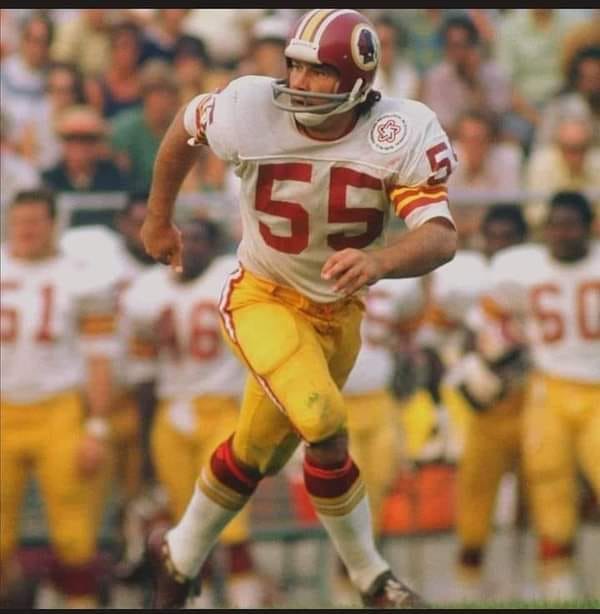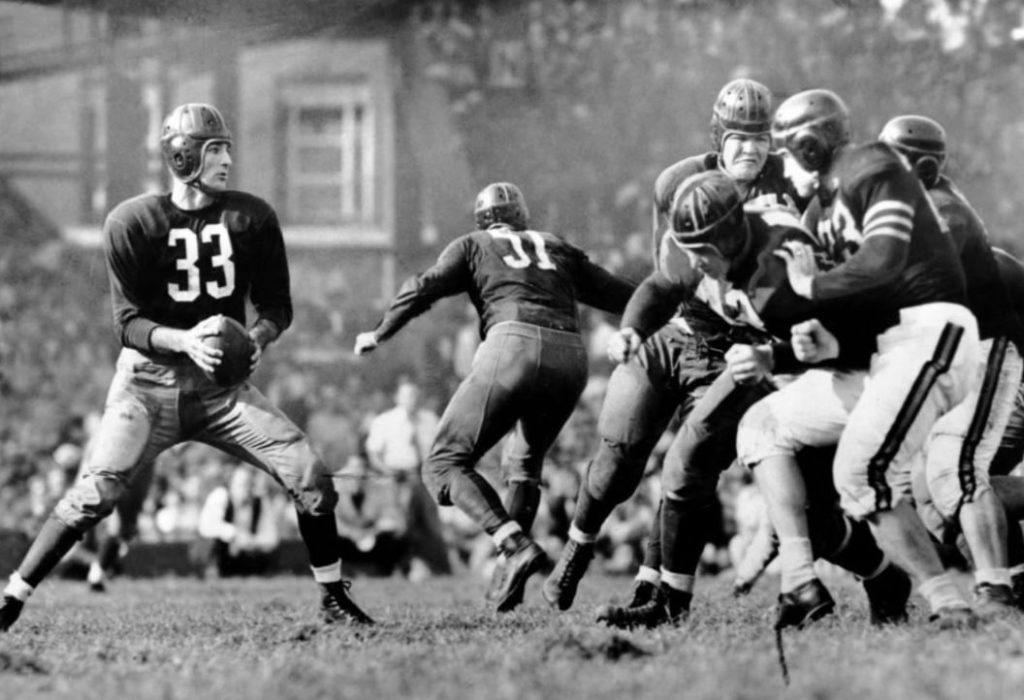
The first thing one has to understand about the NFL draft is the absolute randomness of it. So-called “Mortal Locks” fail at an astounding rate. Inconsequential late-rounders defy odds and bloom. Even players that go undrafted somehow produce. The Hall of Fame includes undrafted players such as Kurt Warner, Larry Little, and Washington nemesis Drew Pearson among a decent number of others. Teams spend millions of dollars to formulate their “Draft Boards.” It’s person-hours of research in staggering amounts combined with travel, consultants, and interviews. Despite all that, in the end, it’s not all that different from picking lottery ping-pong balls. Washington’s immediate football future depends on picking a winner.
Tough Countryside
New WFT General Manager Adam Peters stepped into a tough gig. This is a fanbase absolutely marinated in toxicity for more than two decades. The inherited roster is regarded by many pundits to be the worst in the League. It produced a record poor enough to garner the number 2 pick overall in the Draft. The top of the Draft is for bad teams. Almost always they don’t have a Quarterback. It’s all about need. A team can’t win without a good QB in this modern game. Last year 11 of the 14 playoff teams had a 1st-Round QB. Read any ranking of draftees by absolute value. The QBs are usually taken far above their ranking. The stakes are high. The risk of failure is high. This will be some test for the fledgling GM. His first real foray will be into rough countryside. The road up and out of the seventh-level of football Hell won’t be easy.
One would think that after decades of organizational experience, investment of ungodly sums of currency, and reams of hard data on hand that some sort of wisdom and insight about the Draft would have emerged. One would be wrong. Consider November 9, 2023. The Chicago Bears played the Carolina Panthers. Both were bad teams. On the Carolina side was Bryce Young. He was the #1 pick in the entire draft. On the Bears’ side was Tyson Bagent. His road to the League started at little Shepherd College. His week at the Senior Bowl impressed the Bears’ staff who coached there. The Bears’ signed him as an undrafted Free Agent. The Panthers payed Young roughly $405,000 for the game. The Bears payed Bagent $44,600. They essentially had the same game. 20 of 33 for 162 0 TD versus 21 of 28 for 185 0 TD . Pick ’em. The only significant difference is that Young took 3 sacks, Bagent had zero. Bagent’s team won. Complete opposite ends of the Draft spectrum were on simultaneous display. Yet the difference was hardly perceptible. Is there something wrong with this system?
Conventional wisdom is that a team needs a 1st Round QB in order to reach a Super Bowl. The odds are there. Last years’ 78% rate for 1st Round QBs is fairly typical. It’s the outliers that cause one to stop and wonder. One of the three QBs from last year was Brock Purdy. He’s famous for being the last player selected in the Draft; AKA “Mr. Irrelevant.” He’s been good enough to help get his team into two Conference Championships and one Super Bowl. How was this guy missed by every team for seven rounds until the very last moment?
The answers are tied to a large combination of reasons. But, typically there is an over reliance on Power Five college experience. Bryce Young was phenomenal in college playing for power house Alabama. His Offensive Line was a cut above 90+% of the competition. His Wide Receivers were more open on average than an NFL receiver ever hopes to be. “It’s all about the tape” is the mantra among many Front Offices. Young’s college video tape was a dream. Behind a porous O-Line with sub-standard receivers, and a disastrous Ownership/Leadership team the results were pretty awful. Being thrust into starting from the outset only added more confusion to the mix. Brock Purdy played in obscurity at Iowa State behind some pretty poor linemen. His tape wasn’t much to admire. He lost the beauty pageant by nearly the largest margin possible. But, he’s a winner.
That’s how fickle this Drafting business can be.

What to do?
Young GM Peters absolutely must take a QB with the WFT’s first pick. Right now it’s slated for #2. Every QB except Caleb Williams will be available. The top 3 Draft positions all need QBs. Conventional wisdom is that someone will make a leap to #4 or #5 to take another QB. Minnesota has painted itself into such a QB hole that many of the thousands of mock drafts out there have them taking drastic action. One had them trading #11, #23, the 2025 1st Round, the 2025 4th Round choice, AND Wide Receiver Jordan Addison to the Chargers at #5 for their pick. If you’re Adam Peters and the Vikings call with that package how do you say “No?” This is a roster loaded with needs. One of those needs is for an Edge Rusher. Those are in limited supply. The #23 pick would give them the opportunity to land a solid Edge. Another dire need is for Offensive Tackle. The Draft is rich with those. The two Second-Round selections could be doubled O-Line types. Next year would bring two First-Round selections. It’s a very tantalizing thought.
Wait! What about the QB? Enter one Michael Penix Jr. He should be there at #11. He has the misfortune of having a medical history not unlike a Crash Test Dummy. Two ACL tears on the same leg; two shoulder surgeries, and he’s already 24 years old. There’s such a thing as “Competitive Medical Advantage.” If your team Doctors give the thumbs up while most others’ point down, and the player works out well that is CMA. He could be a candidate. More on him in a minute.
There are studies, and corresponding consultants that say the key to the Draft is to trade down often. In a system of randomness more opportunities equal more chances of success. There are mind-numbing papers out there if one is so inclined. Daniel Snyder hired one of these consulting outfits before a Draft. He ignored all the advice and traded UP. The reason given was, “Mr. Snyder wants to win now.”
Peters has come out and said that the team is comfortable staying at #2. It means as much as a politician’s promise. Assuming he’s being truthful the choices for QB are: Jayden Daniels, Drake Maye, and JJ McCarthy. If you want a list of pros and cons for each it would take a week to read it. But, here’s one type of metric that should be heavily weighted: Sacks versus Pressures. One carryover from College to Pros is the propensity to be sacked when blitzed or pressured. Sam Howell had a very poor college grade in this area. It carried over, big time. Patrick Mahomes had a high grade. “Pressures” are not the most solid of metrics. But, Blitzes can be accurately counted.
Sacks versus Blitzes-faced paints a picture that gives reason for pause. In the NFL first-year player CJ Stroud was sacked once every twelve times he was blitzed. Patrick Mahomes, behind two atrocious tackles was only sacked once every 22 times. This list of Draftees has some very different marks: Caleb Williams. once every 3.9 times: Drake May, once every 4 times; JJ McCarthy, once every 5 times; and Jayden Daniels, once every 2.9 times . The outlier is Penix; once every 11 times. That 2.9 number for Daniels is disconcerting.
The Cardinal Sin for a young QB is to hold onto the ball too long. It’s a tough habit to break. So much so that it is often the limiting factor. Caleb Williams made 60% of his pass completions on “Off-Schedule” throws. Hold the ball and scramble. It’s a necessary skill for use on occasion. But, it won’t provide a living in the Bigs. Penix already has the skill to get rid of the ball. The coaching staff wouldn’t have to teach a skill that is often un-learnable. But, coaches think they can fix a player’s faults. Sometimes they actually succeed.
Conventional wisdom has Jayden Daniels coming to Washington with the #2 pick. But, that is a conclusion reached without inside knowledge. It’s more of a collective guess than reporting of fact. One thing the new Owner and GM have done is tighten the ship at Ashburn. No one outside knows exactly what they are thinking. That alone is a huge step forward. The next huge step comes on Thursday evening. We’ll all have to tune it to find out what it will be.
Whoever is chosen to the be the next QB will ironically share the room with Marcus Mariota. He was the 2nd overall pick in the 2015 Draft. No one would call his career a huge success except his Accountant. It’s an all-too-close reminder of the perils facing the WFT when they go on the clock with the second overall pick on Thursday.

